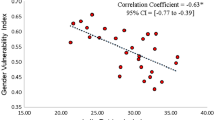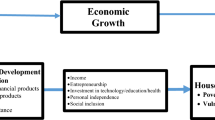Abstract
Different from prior studies that examined the impact of economic, demographic, and behavioral factors on homeownership, this paper adds to the literature by explaining homeownership from the Confucian culture. Based on the dataset of the 2011 China Household Finance Survey, the results showed that a household head with more siblings was more likely to own a house, suggesting the interdependence within family members; when we divided the sample into male and female groups according to the gender of the household head, we found that the “sibling effect” only existed in male household heads, and both sisters and brothers contributed to the increase in the likelihood of owning a house, suggesting strong son preference. Additionally, we found that the “sibling effect” mainly arose from household heads with low- and middle-income or those living in high sex-ratio regions, which further supported our arguments. Finally, we analyzed the evolution of the interdependence within families in homeownership due to two important economic and demographic policies in China’s history: the reform and opening-up policy and the one-child policy.

source: China’s Informal Finance Development Report in 2014

source: China’s Informal Finance Development Report in 2014
Similar content being viewed by others
Notes
Survey and Research Center for China Household Finance, 2014. China’s Informal Finance Development Report.
See Kirkman et al. (2006) for a comprehensive review of the literature.
The China Household Finance Survey (CHFS) has been conducted four times in 2011, 2013, 2015, and 2017. The data of the first round of the survey have been made fully available to researchers since 2012. Since we have no permission to use the other rounds of the data, we are only able to leverage the first round of the survey in 2011 to examine the impact of the Confucian culture on homeownership.
See Gan et al. (2014) for a more detailed description about the survey.
The provinces in the high-sex-ratio group include Jiangxi, Guangdong, Anhui, Henan, Guangxi, Hubei, Hunan, Shaanxi, Jiangsu, Gansu, Beijing and Zhejiang. The remaining 13 provinces belong to the low-sex-ratio group.
References
Badev, A., Beck, T., Vado, L., & Walley, S. (2014). Housing finance across countries: New data and analysis. World Bank Policy Research Working Paper, WPS6756. Retrieved from https://papers.ssrn.com/sol3/papers.cfm?abstract_id=2336126.
Balakrishnan, T. R., & Wu, Z. (1992). Home ownership patterns and ethnicity in selected Canadian cities. The Canadian Journal of Sociology, 17, 389–403. Retrieved from https://www.jstor.org/stable/3341216.
Beugelsdijk, S., & Frijns, B. (2010). A cultural explanation of the foreign bias in international asset allocation. Journal of Banking & Finance, 34(9), 2121–2131. https://doi.org/10.1016/j.jbankfin.2010.01.020.
Bian, W. L., Ji, Y., & Zhang, H. (2019). Does dialect similarity add value to banks? Evidence from China. Journal of Banking and Finance, 101(4), 226–241. https://doi.org/10.1016/j.jbankfin.2019.02.013.
Chakrabarti, R., Gupta-Mukherjee, S., & Jayaraman, N. (2009). Mars-Venus marriages: Culture and cross-border M&A. Journal of International Business Studies, 40(2), 216–236. https://doi.org/10.2307/25483372.
Chui, A. C. W., Titman, S., & Wei, K. C. J. (2010). Individualism and momentum around the world. The Journal of Finance, 65(1), 361–392. https://doi.org/10.1111/j.1540-6261.2009.01532.x.
Clark, W. A., & Ledwith, V. (2012). Mobility, housing stress, and neighborhood contexts: Evidence from Los Angeles. Environment and Planning A, 38(6), 1077–1093. https://doi.org/10.1068/a37254.
Cohen, T. R., Lindblad, M. R., Paik, J. G., & Quercia, R. G. (2009). Renting to owning: an exploration of the theory of planned behavior in the homeownership domain. Basic and Applied Social Psychology, 31(4), 376–389. https://doi.org/10.1080/01973530903316971.
Das Gupta, M., Zhenghua, J., Bohua, L., Zhenming, X., Chung, W., & Hwa-Ok, B. (2003). Why is son preference so persistent in east and south Asia? a cross-country study of china, india and the republic of Korea. Journal of Development Studies, 40(2), 153–187. https://doi.org/10.1080/00220380412331293807.
de Bary, W. T., Chan, W., & Watson, B. (1960). Sources of Chinese Tradition, Vols. 1 and 2, New York: Columbia University Press.
Drew, R. B., (2014). Believing in homeownership: Behavioral drivers of housing tenure decisions. Joint Center for Housing Studies working paper, w14–3. Retrieved from https://jchs.harvard.edu/sites/jchs.harvard.edu/files/w14-3_drew.pdf.
Ebenstein, A., & Leung, S. (2010). Son preference and access to social insurance: Evidence from China’s rural pension program. Population and Development Review, 36(1), 47–70. https://doi.org/10.1111/j.1728-4457.2010.00317.x.
Edlund, L., Li, H., Yi, J., & Zhang, J. (2013). Sex ratios and crime: Evidence from China. The Review of Economics and Statistics, 95(5), 1520–1534. https://doi.org/10.1162/REST_a_00356.
El Ghoul, S., & Zheng, X. (2016). Trade credit provision and national culture. Journal of Corporate Finance, 41, 475–501. https://doi.org/10.1016/j.jcorpfin.2016.07.002.
Fisman, R., Paravisini, D., & Vig, V. (2017). Cultural proximity and loan outcomes. American Economic Review, 107, 457–492. https://doi.org/10.1257/aer.20120942.
Fu, K. (2013). A review of housing tenure choice. In Proceedings of the 17th International Symposium on Advancement of Construction Management and Real Estate, edited by J. Want, Z. Ding, L. Zou, and J. Zuo, 351–60. Berlin: Springer.
Fu, Q., & Lin, N. (2013). Local State Marketism: An Institutional Analysis of China's Urban Housing and Land Market. Chinese Sociological Review, 46(1), 3–24. https://doi.org/10.2753/CSA2162-0555460101.
Gabriel, S., & Painter, G. (2003). Pathways to Homeownership: An Analysis of the Residential Location and Homeownership Choices of Black Households in Los Angeles. The Journal of Real Estate Finance and Economics, 27(1), 87–109. https://doi.org/10.1023/A:1023611513835.
Gan, L., Yin, Z., Jia, N., Xu, S., Ma, S., & Zheng, L. (2014). Research Report of China Household Finance Survey 2012. Springer. https://doi.org/10.1007/978-3-642-38151-5.
Gao, E., Zuo, X., Wang, L., Lou, C., Cheng, Y., & Zabin, L. S. (2012). How does traditional Confucian culture influence adolescents’ sexual behavior in three Asian cities? Journal of Adolescent Health, 50(3), 12–17. https://doi.org/10.1016/j.jadohealth.2011.12.002.
Goodman, L. S., & Mayer, C. (2018). Homeownership and the American Dream. Journal of Economic Perspectives, 32, 31–58. https://doi.org/10.1257/jep.32.1.31.
Gyourko, J., & Linneman, P. (1996). Analysis of the changing influences on traditional households’ ownership patterns. Journal of Urban Economics, 39(3), 318–341. https://doi.org/10.1006/juec.1996.0017.
Haurin, D. R., & Gill, H. L. (1987). Effects of income variability on the demand for owner-occupied housing. Journal of Urban Economics, 22(2), 136–150. https://doi.org/10.1016/0094-1190(87)90036-2.
Haurin, D., Hendershott, P., & Wachter, S. (1997). Borrowing constraints and the tenure choice of young households. Journal of Housing Research, 8(2), 137–154.
Hendershott, P. H., & Pryce, G. (2006). The sensitivity of homeowner leverage to the deductibility of home mortgage interest. Journal of Urban Economics, 60(1), 50–68. https://doi.org/10.1016/j.jue.2006.01.003.
Henderson, J. V., & Ioannides, Y. M. (1983). A Model of Housing Tenure Choice. American Economic Review, 73(1), 98–113. https://doi.org/10.1016/0309-586X(83)90028-6.
Hofstede, G. (1980). Culture’s consequences—International differences in work-related values. Newbury Park: SAGE Publications Inc.
Hofstede, G., & Bond, M. H. (1988). The Confucius connection: From cultural roots to economic growth. Organizational Dynamics, 16(4), 5–21. https://doi.org/10.1016/0090-2616(88)90009-5.
Hofstede, G. (1994). Management scientists are human. Management Science, 40(1), 4–13. https://doi.org/10.1287/mnsc.40.1.4.
Huang, W. & Zhou, Y. (2015). One-child policy, marriage distortion, and welfare loss. IZA Discussion Paper No. 9532. Retrieved from https://papers.ssrn.com/sol3/papers.cfm?abstract_id=2696370.
Jansen, S. J. T., Coolen, H., & Goetgeluk, R. W. (2011). The measurement and analysis of housing preference and choice. New York: Springer.
Kain, J. F. & Quigley, J. M. (1972). Housing market discrimination, home-ownership, and savings behavior. The American Economic Review 62(3), 263–277. Retrieved from https://www.jstor.org/stable/1803375.
Kirkman, B. L., Lowe, K. B., & Gibson, C. B. (2006). A quarter century of Culture’s Consequences: A review of empirical research incorporating Hofstede’s cultural values framework. Journal of International Business Studies, 37(3), 285–320. https://doi.org/10.1057/palgrave.jibs.8400202.
Kogut, B., & Singh, H. (1988). The effect of national culture on the choice of entry mode. Journal of International Business Studies, 19(3), 411–432. https://doi.org/10.1057/palgrave.jibs.8490394.
Li, S. M., & Li, L. (2006). Life course and housing tenure change in urban china: a study of Guangzhou. Housing Studies, 21(5), 653–670. https://doi.org/10.1080/02673030600807159.
LinY, J. (2013). Demystifying the Chinese economy. The Australian Economic Review, 46(3), 259–268. https://doi.org/10.1111/j.1467-8462.2013.12035.x.
Manturuk, K. R. (2012). Urban homeownership and mental health: Mediating effect of perceived sense of control. City & Community, 11(4), 409–430. https://doi.org/10.1111/j.1540-6040.2012.01415.x.
Marcén, M., & Morales, M. (2019). The effect of culture on home-ownership. Journal of Regional Science, online.. https://doi.org/10.1111/jors.12433.
McMillan, J., Whalley, J., & Zhu, L. (1989). The impact of China’s economic reforms on agricultural productivity growth. Journal of Political Economy, 97(4), 781–807. https://doi.org/10.1086/261628.
Mulder, C. H., & Wagner, M. (1998). First-time home-ownership in the family life course: A west German-Dutch comparison. Urban Studies, 35(4), 687–713. https://doi.org/10.1080/0042098984709.
Narwold, A., & Sonstelie, J. (1994). State Income Taxes and Homeownership: A test of the tax arbitrage theory. Journal of Urban Economics, 36(3), 249–277. https://doi.org/10.1006/juec.1994.1035.
Park, M., & Chesla, C. (2007). Revisiting Confucianism as a conceptual framework for Asian family study. Journal of Family Nursing, 13(3), 293–311. https://doi.org/10.1177/1074840707304400.
Quercia, R. G., McCarthy, G. W., & Wachter, S. M. (2003). The impacts of affordable lending efforts on homeownership rates. Journal of Housing Economics, 12(1), 29–59. https://doi.org/10.1016/s1051-1377(03)00004-4.
Ortalo-Magné, F., & Rady, S. (2002). Tenure choice and the riskiness of non-housing consumption. Journal of Housing Economics, 11(3), 266–279. https://doi.org/10.1016/s1051-1377(02)00100-6.
Rosen, H. S. (1979). Housing decisions and the US income tax: an econometric analysis. Journal of Public Economics, 11(1), 1–23. https://doi.org/10.1016/0047-2727(79)90042-2.
Shane, S. A. (1993). The effect of cultural differences in perceptions of transactions cots on national differences in the preference for international joint ventures. Asia Pacific Journal of Management, 10, 57–69. https://doi.org/10.1007/BF01732224.
Shiller, R. (2005). Irrational Exuberance. Princeton University Press, Princeton and Oxford.. https://doi.org/10.1515/9781400865536.
Sinai, T., & Souleles, N. S. (2005). Owner-Occupied Housing as a Hedge against Rent Risk. The Quarterly Journal of Economics, 120(2), 763–789. https://doi.org/10.1093/qje/120.2.763.
Reid, C. (2013). To buy or not to buy? Understanding tenure preferences and the decision-making processes of lower-income households. Working Paper HBTL-14. Cambridge, MA: Joint Center for Housing Studies, Harvard University.
Varsakelis, N. C. (2001). The impact of patent protection, economy openness and national culture on R&D investment: A cross-country empirical investigation. Research Policy. https://doi.org/10.1016/S0048-7333(00)00130-X.
Wang, S., & Zhou, W. (2017). Family structure and home ownership: Evidence from China. China Economic Review, 46(12), 165–179. https://doi.org/10.1016/j.chieco.2017.09.003.
Wei, S., & Zhang, X. (2011). The competitive saving motive: Evidence from sex ratios and saving rates in China. Journal of Political Economy, 119(3), 511–564. https://doi.org/10.1086/660887.
Wong, N. Y., & Ahuvia, A. C. (1998). Personal taste and family face: Luxury Consumption in Confucian and western societies. Psychology & Marketing, 15(5), 423–441. https://doi.org/10.1002/(SICI)1520-6793(199808)15:5%3c423:AID-MAR2%3e3.0.CO;2-9.
Yao, X. (2000). An introduction to Confucianism. Cambridge University Press, New York.. https://doi.org/10.1017/CBO9780511800887.
Yates, J. (2002). Housing implications of social, spatial and structural change. Housing Studies, 17(4), 581–618. https://doi.org/10.1080/02673030220144367.
Yum, J. (1988). The impact of Confucianism on interpersonal relationships and communication patterns in East Asia. Communication Monographs, 55(4), 374–388. https://doi.org/10.1080/03637758809376178.
Zingales, L. (2015). The “cultural revolution” in finance. Journal of Financial Economics, 117(1), 1–4. https://doi.org/10.1016/j.jfineco.2015.05.006.
Zumbro, T. (2014). The relationship between homeownership and Life Satisfaction in Germany. Housing Studies, 29(3), 319–338. https://doi.org/10.1080/02673037.2013.773583.
Acknowledgements
We acknowledge the support of the National Natural Science Foundation of China (Nos. 71603061), the Natural Science Foundation of Guangdong (Nos. 2019A1515011649).
Author information
Authors and Affiliations
Corresponding author
Additional information
Publisher's Note
Springer Nature remains neutral with regard to jurisdictional claims in published maps and institutional affiliations.
Appendix
Rights and permissions
About this article
Cite this article
Wu, B., Bian, W., Xue, Y. et al. Confucian Culture and Homeownership: Evidence from Chinese Families. J Fam Econ Iss 42, 182–202 (2021). https://doi.org/10.1007/s10834-020-09685-w
Published:
Issue Date:
DOI: https://doi.org/10.1007/s10834-020-09685-w




